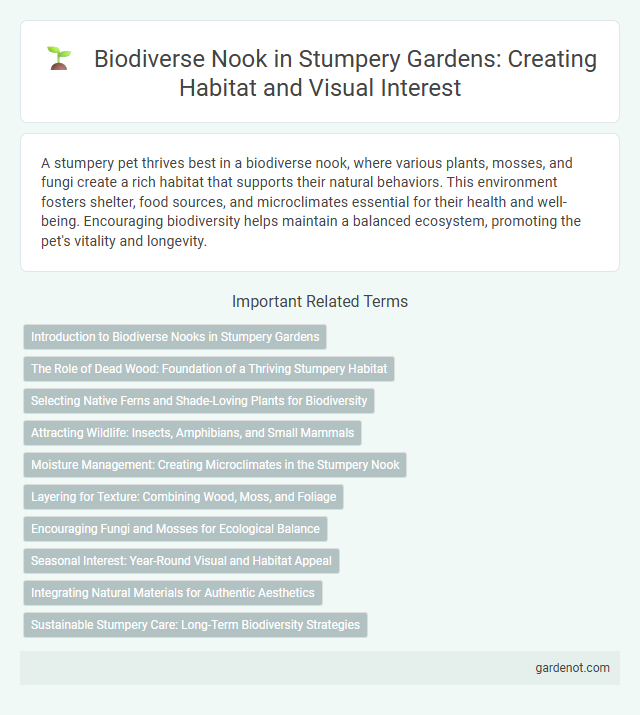A stumpery pet thrives best in a biodiverse nook, where various plants, mosses, and fungi create a rich habitat that supports their natural behaviors. This environment fosters shelter, food sources, and microclimates essential for their health and well-being. Encouraging biodiversity helps maintain a balanced ecosystem, promoting the pet's vitality and longevity.
Introduction to Biodiverse Nooks in Stumpery Gardens
Biodiverse nooks in stumpery gardens create microhabitats by integrating decaying wood, mosses, and native plants that support diverse insect, fungal, and amphibian species. These shaded, moisture-retentive environments enhance ecosystem functions such as pollination and soil health, promoting ecological balance within garden spaces. Incorporating fallen logs and varied plant structures fosters niche habitats essential for urban biodiversity conservation.
The Role of Dead Wood: Foundation of a Thriving Stumpery Habitat
Dead wood serves as a vital foundation in a stumpery, providing essential habitats for diverse fungi, insects, and microorganisms that drive nutrient cycling and ecological balance. This decomposing material supports a complex web of life, fostering plant growth and enhancing biodiversity in shaded garden niches. By retaining moisture and creating microhabitats, dead wood ensures a thriving stumpery ecosystem that sustains rare and specialized species.
Selecting Native Ferns and Shade-Loving Plants for Biodiversity
Selecting native ferns such as Polystichum acrostichoides and Dryopteris marginalis enhances a stumpery's biodiversity by providing essential habitat and food sources for local wildlife. Shade-loving plants like Trillium and wild ginger thrive in the cool, damp microclimate created by stumperies, promoting a balanced ecosystem. Incorporating a variety of native species ensures robust soil health and supports pollinators, enriching the niche's overall ecological value.
Attracting Wildlife: Insects, Amphibians, and Small Mammals
A stumpery creates a biodiverse nook by providing shelter and nesting sites that attract insects, amphibians, and small mammals, enhancing local ecosystem health. Decaying wood supports fungi and invertebrates, which in turn serve as food for various wildlife. This habitat complexity encourages species diversity and fosters natural pest control.
Moisture Management: Creating Microclimates in the Stumpery Nook
The stumpery nook thrives by strategically managing moisture to create diverse microclimates that support various plant species. Fallen logs and decaying wood retain humidity, encouraging mosses, ferns, and shade-loving flora to flourish in this biodiverse habitat. Effective moisture regulation in these niches enhances soil health and fosters a rich ecosystem within the stumpery.
Layering for Texture: Combining Wood, Moss, and Foliage
Layering wood, moss, and foliage creates a richly textured stumpery that supports diverse wildlife and enhances ecological balance. The varying surfaces of rough wood, soft moss, and vibrant foliage provide essential habitats for insects, birds, and fungi, fostering a biodiverse microhabitat. This combination also promotes moisture retention and soil health, making the stumpery a sustainable and visually dynamic garden feature.
Encouraging Fungi and Mosses for Ecological Balance
Creating a biodiverse nook in a stumpery promotes ecological balance by encouraging the growth of fungi and mosses, which play crucial roles in nutrient cycling and habitat provision. Fungi decompose organic matter, enriching the soil and supporting plant health, while mosses retain moisture and provide microhabitats for invertebrates. This symbiotic environment enhances biodiversity and fosters a resilient garden ecosystem.
Seasonal Interest: Year-Round Visual and Habitat Appeal
A stumpery creates a biodiverse nook by combining decaying wood, ferns, mosses, and shade-loving plants that support various insects and small wildlife throughout the year. Seasonal interest is maintained with evergreen mosses and winter-hardy ferns providing winter texture, spring wildflowers adding vibrant color, and autumn leaves contributing rich tones and shelter. This layered habitat fosters ecological balance, promoting continual visual appeal and wildlife activity across all seasons.
Integrating Natural Materials for Authentic Aesthetics
A stumpery thrives as a biodiverse nook by integrating natural materials like decayed wood, moss, and ferns, creating an authentic habitat for insects and shade-loving plants. Utilizing fallen tree stumps and branches not only enhances ecological balance but also supports fungi growth and microfauna diversity. This naturalistic approach promotes sustainability while enriching the garden's visual and biological complexity.
Sustainable Stumpery Care: Long-Term Biodiversity Strategies
A biodiverse nook in a stumpery thrives through sustainable care practices that prioritize native plant selection and habitat creation to support local wildlife. Incorporating decaying wood and organic mulch maintains soil health and moisture, fostering beneficial fungi and invertebrates crucial for ecosystem balance. Regular monitoring and adaptive management ensure long-term biodiversity resilience, enhancing the stumpery's ecological value.
Biodiverse nook Infographic

 gardenot.com
gardenot.com